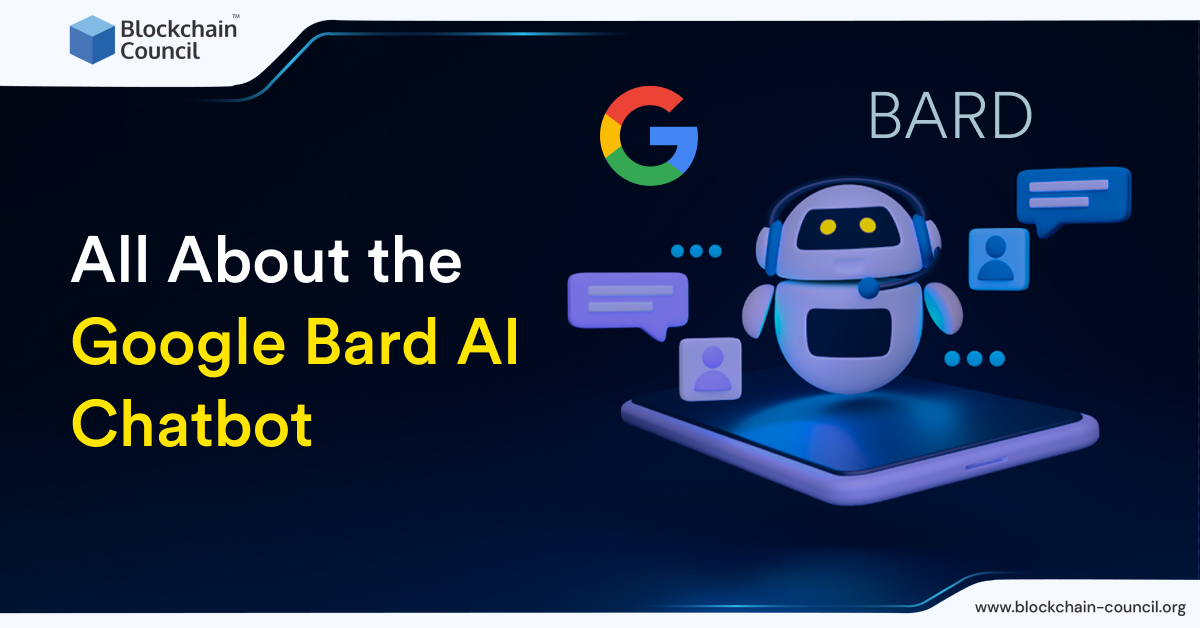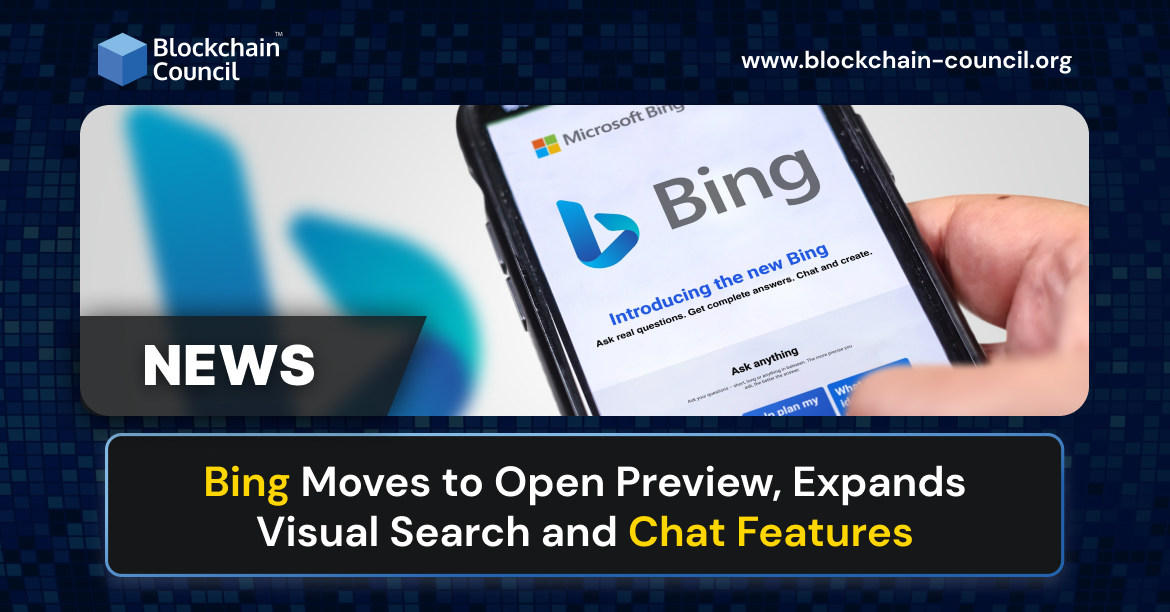
- Blockchain Council
- June 02, 2023
Summary:
- Google Bard, an AI-powered chatbot, has been introduced by Google, offering conversational AI to a wider audience.
- Bard is a generative AI powered by Google's Language Model for Dialogue Applications (LaMDA), designed for text-based content generation and natural conversation.
- Google has expanded Bard's availability to 180 English-speaking countries, introduced Japanese and Korean chat abilities, and plans to support 40 languages.
- Bard aims to provide information in various areas such as poetry, philosophy, software development, exam preparation, and tax advice, potentially replacing an inefficient workforce.
- Ethical implications and concerns regarding AI model development and regulation have been raised, emphasizing the need for responsible practices and potential risks to society.
- Users can access Bard by visiting Bard.google.com, where it offers features like internet access, mobile accessibility, image responses, plugins, voice prompts, and integration with Gmail and Google Docs.
- Bard provides advantages over ChatGPT, including internet access, mobile accessibility, image responses, plugins, image prompts, voice prompts, enhanced search, integration with Gmail, and support for programming languages.
- Bard's future includes incorporating visual elements, integrating with Google's suite of products, and expanding its capabilities.
- Despite initial challenges and competition, Google is committed to advancing Bard and positioning it as a powerful conversational AI tool.
- Bard is currently in testing phases and may eventually be integrated into Google Search, revolutionizing how users receive detailed answers in plain English.
The arrival of Google Bard has brought conversational AI to a wider audience. After two months of limited testing, Google has removed the waitlist for access to its AI-powered chatbot. This announcement was made during the Google I/O developer conference. Similarly, Microsoft recently eliminated the waitlist for its competing chatbot on Bing to show its cards to the competition finals. Google has expanded Bard’s availability to people in 180 English-speaking countries and territories.
And as part of its language expansion plan, it has introduced Japanese and Korean chat abilities to support 40 languages. With the increasing abilities of LLMs, more and more businesses are trying to amalgamate them into their operations to make the workings more efficient and self-sufficient.
This revolution in computing enables chatbots to provide a wealth of information through a natural interface which is another lucrative prospect for enterprises. They have demonstrated capabilities in diverse areas, including poetry writing, philosophy discussions, software development, exam preparation, and tax advice.
If they continue to grow at the current rate, there is a huge potential for them in different industries and spheres where they can replace a substantial amount of inefficient workforce. In this article, we will discuss Bard in great detail and cover all its necessary aspects to help you understand if it is the next big thing for Google or has already fallen behind OpenAI in AI development.
What is Google Bard?
Bard, developed by Google, is a generative AI and falls under large language models (LLMs). It is focused on creating text-based content and answering questions naturally and conversationally. Bard is powered by Google’s Language Model for Dialogue Applications (LaMDA), released in 2021. Google has been working on LLMs since 2017 when it made its Transformer deep learning model available to the public. Bard results from years of development and builds upon the foundation laid by Google’s previous language models.
Bard’s development is a top priority for Google, as evidenced by the company restructuring its Assistant team and allocating more AI specialists to work on Bard. Since its debut, Google has consistently added features and improvements to Bard, indicating its long-term commitment to the chatbot. While Bard may have similarities to OpenAI’s ChatGPT, Since its debut, ChatGPT has had unique features and capabilities, such as integrating up-to-date information and handling voice prompts.
With ongoing development and a dedicated team behind it, Bard is poised to continue evolving and expanding its capabilities in the future. With the advent of ChatGPT, Google was facing a serious threat to its position as a mammoth in the tech world, where it controlled a huge portion of data that got transferred over the internet. Still, with ChatGPT, the way people access information changed substantially, and with Bard, Google is trying to fix the loss caused by its lethargic position on LLMs and their development in the past.
How does Google Bard work?
Google Bard aims to complement the Knowledge Graph Cards in search results by answering NORA (No One Right Answer) questions. While Knowledge Graph Cards offer concise information, Bard is designed to understand and respond to nuanced questions by leveraging the LaMDA language models. LaMDA enables Bard to grasp the context and colloquialisms in dialogue-based datasets, enhancing its understanding of queries.
To generate its responses, Bard utilizes information from across the web and employs the conversational capabilities of LaMDA to deliver answers that resemble those of a human conversation. Google intends for Bard and other AI chatbots to provide high-quality responses, facilitating user understanding and decision-making processes.
During demonstrations, Bard has been shown to assist users in decision-making scenarios, such as choosing a car, and can engage in follow-up discussions to delve deeper into specific topics. This functionality could reduce the need for users to click on search results. However, Google remains committed to supporting content creators and maintaining a healthy, open web ecosystem, ensuring valuable traffic is directed to various sources.
Bard exists as a standalone utility rather than integrated directly into Google Search. Users can engage in a chat session with the AI, and the context of previous questions within a session is remembered, allowing for more refined and contextualized responses. Bard also can correct itself if it provides inaccurate information, showcasing a commitment to accuracy and quality.
What are some Ethical implications of its launch?
AI chatbots like Bard, ChatGPT-4, and others may indeed provide quick answers that are only sometimes correct. These platforms can be influenced by biases in training data, conflicting or outdated information, and even generate made-up facts in some cases, as highlighted by CNET’s Wordsmith. As an experienced company in information retrieval, Google has mechanisms to sort fact from fiction and prioritize accurate information.
Google’s Featured Snippets, for example, employ machine learning models to collect data from various online sources, quantify sentiment and other variables, and filter out answers that fall outside a midrange. This process helps provide responses considered safe opinions or accurate information based on the available data.
The biggest ethical challenge, apart from the ones that can be easily solved, is how much we need to develop these models. The current rate of development has spooked many experts who believe there need to be some regulations to monitor it and ensure that it doesn’t lead to something catastrophic for us in the future.
Dr. Geoffrey Hinton, a prominent AI researcher and former Google employee, recently resigned and expressed concerns about the rapid advancement of generative AI models. He believes that the pace of development may make it challenging to regulate these technologies and could be exploited by malicious actors. While Google maintains a commitment to responsible AI development, Hinton suggests that the industry’s push to win over users, exemplified by the rise of ChatGPT, has compelled the company to accelerate the development of Bard.
Over a thousand industry leaders, including Tesla CEO Elon Musk, have called for a six-month moratorium on developing AI models, expressing concerns about their risks to society and humanity. These leaders argue that companies like Google, Microsoft, and OpenAI are racing to create increasingly powerful AI systems that may become difficult to understand, predict, or control.
In an interview, Google CEO Sundar Pichai acknowledged that an aspect of AI development remains a “black box” and is not fully understood. The concerns raised by Dr. Geoffrey Hinton and the open letter from industry leaders highlight the need for responsible development and regulation of AI models to ensure their benefits are harnessed while mitigating potential risks to society.
Become a Certified Chatbot Expert™
How can you use Bard?
To use Google Bard, visit Bard.google.com and log in with your Google account. After agreeing to the terms of service, you can start using Bard. The interface is similar to ChatGPT, with an empty text field to enter your prompt or question. Google provides random prompt ideas to get started, and Bard will respond with an answer. For example, if you ask for a fast, balanced, vegetarian meal high in protein and fiber, Bard may suggest options like tofu scramble, lentil soup, and vegetarian stir-fry.
You can continue the conversation in any direction, asking for more meal ideas or specific recipes. One notable feature of Bard is that it provides multiple drafts of each response. You can view other drafts for alternative answers or click “Regenerate drafsidebar’s sidebar’s ts” for another attempt. However, regenerating drafts often produces similar results, so editing the prompt or trying a new one may be more effective in getting a different answer.
All your chats with Bard are in a single scroll window, which will be deleted if you close the window. While you can’t directly access the past answers, you can see and delete all the prompts in the “Bard activity” section in the sidebar. You can also export Bard’s responses to Gmail, Google Docs, or Replit by clicking the share icon and selecting the desired destination. Google Bard also offers a Dark Mode, activated by clicking on the sidebar’s toggle in the bottom left corner.
Google Bard Vs ChatGPT
Aspect |
Google Bard |
ChatGPT |
|---|---|---|
Access to Web |
Yes |
No |
Mobile Accessibility |
Yes (Integrated) |
No dedicated app |
Image Responses |
Yes |
No |
Plugins |
Walmart, Spotify, Uber Eats, Adobe Firefly, Google Apps |
Limited availability for ChatGPT Plus subscribers |
Voice Prompts |
Yes |
No |
Export to Gmail and Docs |
Yes |
Yes (through extensions) |
Enhanced Search |
Yes |
No |
Integration with Gmail |
Yes |
No |
Support for Programming |
Yes (over 20 languages) |
Limited capabilities |
Future of Bard
Bard has various potential applications across various domains, similar to ChatGPT. Businesses and users can leverage Bard to save time and resources by consistently generating content and creative writing. It can assist in code generation for developers, help create engaging marketing campaigns with conversational slogans and taglines, and serve as a learning tool for students.
Google acknowledges that the AI chatbot is still not working to its full potential. During Google’s I/O 2023 event, it was announced that Bard would focus on incorporating visual elements into its responses, indicating that future updates may include images alongside text more comprehensively.
Google also plans to integrate Bard more extensively with its search engine. The company also aims to enable users to include images in their prompts by integrating Google Lens with Bard. Integration with Google’s suite of products, including Drive, Gmail, and Docs, is also on the horizon.
The launch of Bard in India and other nations outside the USA comes after a tumultuous initial unveiling that experienced technical glitches and incorrect answers, causing Alphabet, Google’s parent company, to suffer a significant market value loss of $100 billion.
Despite the delayed rollout and competition from Microsoft-backed OpenAI, Google is leveraging its technology and data capabilities to ramp up the AI war as innovations emerge. When asked about the latter, Bard expressed confidence in its capabilities compared to ChatGPT. It described itself as a more powerful and versatile language model, highlighting its access to more data, a newer architecture, and greater task capabilities, positioning itself as the only conversational AI tool.
When the options are abundant, businesses can choose whatever fits them the best. But, as a learner and professional, you must ensure you are not negligent. Suppose you want to learn more about Bard and the opportunities it can bear. In that case, Blockchain Council has courses curated by experts to help you in a structured manner and provide all the necessary information and skills to use these tools at their full potential.
Conclusion
Bard is in its testing phases, but once it completes these phases, it will likely be integrated into Google Search. The feature will become as simple as entering your query into the search bar. Instead of receiving a knowledge card and a list of links, you can expect a detailed answer in plain English. You can only explore the possibilities Bard holds for now, but if we learn anything from the recent trend, it’s poised to become one of the major tools in a few years.
Bard is Google’s answer to ChatGPT, but it must go through many updates to reach that level. But the recent focus and developments indicate that Google is taking every stone to tread in front of its competitors. It’s a great chance for individuals to learn and understand the underlying concept, as when the system starts becoming more complex, comprehending it will be much tougher and time-consuming.
Become a Certified Chatbot Expert™
Frequently Asked Questions
Google Bard serves as a valuable tool for poetry enthusiasts and those seeking to engage uniquely with the world of poetry. It offers an interactive platform for users to explore and experience AI-generated poetic compositions, allowing for an immersive and creative engagement with language and literature. Google Bard is a large language model (LLM) that can be used for a variety of tasks, including:
- Answering questions in a comprehensive and informative way, even if they are open-ended, challenging, or strange.
- Generating different creative text formats, like poems, code, scripts, musical pieces, emails, letters, etc.
- Translating languages.
- Writing different kinds of creative content.
- Following your instructions and completing your requests thoughtfully.
Google Bard is not open source. It is a proprietary tool developed and maintained by Google, meaning the source code and underlying technology are not publicly available for modification or distribution.
Google named their tool “Bard” to pay homage to Bards’ historical significance and cultural heritage. Bards were revered figures in ancient traditions, known for their skill in composing and reciting poetry. By choosing the name “Bard,” Google aims to capture the essence of poetic expression and celebrate the rich legacy of oral tradition.
The availability and support for Google Bard may vary across different countries. While Google strives to make its tools and services accessible globally, factors such as regional restrictions, language support, and platform compatibility can influence the availability of Bard in specific countries. To determine the countries in which Bard is supported, it is advisable to refer to official announcements or consult Google’s documentation for the most up-to-date information.





































































 Guides
Guides News
News Blockchain
Blockchain Cryptocurrency
& Digital Assets
Cryptocurrency
& Digital Assets Web3
Web3 Metaverse & NFTs
Metaverse & NFTs
